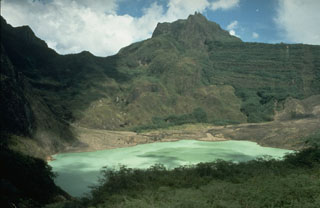Report on Kelud (Indonesia) — February 2001
Bulletin of the Global Volcanism Network, vol. 26, no. 2 (February 2001)
Managing Editor: Richard Wunderman.
Kelud (Indonesia) Changes in water temperature, surface level, and pH detected in crater lake
Please cite this report as:
Global Volcanism Program, 2001. Report on Kelud (Indonesia) (Wunderman, R., ed.). Bulletin of the Global Volcanism Network, 26:2. Smithsonian Institution. https://doi.org/10.5479/si.GVP.BGVN200102-263280
Kelud
Indonesia
7.935°S, 112.314°E; summit elev. 1730 m
All times are local (unless otherwise noted)
Monitoring of Kelut's crater lake indicated a relative increase of water temperature, a rise in surface level, and a decrease in pH into late February 2001. The Volcanological Survey of Indonesia (VSI) released new information revealing that temperatures actually began to rise as of 8 January 2001, rather than on 19 February as disclosed in a previous report (BGVN 25:12). The lake reached a maximum temperature of 51.2°C on 30 January (table 1).
Table 1. Crater lake temperatures during 8 January-26 February 2001 and pH during November 2000-February 2001. The maximum temperature increase was 12.7°C, while the overall increase for the period was 9.3°C. In contrast, pH decreased. Courtesy of VSI.
| Date | Water Temperature (°C) | pH |
| Nov 2000 | -- | 6.9 |
| Jan 2001 | -- | 6.3 |
| 08 Jan 2001 | 38.5 | -- |
| 18 Jan 2001 | 47.5 | -- |
| 19 Jan 2001 | 49.1 | -- |
| 29 Jan 2001 | 50.1 | -- |
| 30 Jan 2001 | 51.2 | -- |
| 02 Feb 2001 | 50.1 | -- |
| 07 Feb 2001 | 51.0 | 5.0 |
| 13-19 Feb 2001 | 47.5 | 5.3 |
| 20-26 Feb 2001 | 47.8 | 5.3 |
A 60-cm increase in lake water level was observed as of 19 January relative to the height at an undisclosed earlier date. Workers measured pH values of the crater lake water and detected a significant overall decrease in pH, or an increase in acidity (table 1). VSI maintained a hazard status of 2 (on a scale of 1-4) since 19 January 2001.
Geological Summary. The relatively inconspicuous Kelud stratovolcano contains a summit crater lake that has been the source of some of Indonesia's most deadly eruptions. A cluster of summit lava domes cut by numerous craters has given the summit a very irregular profile. Satellitic cones and lava domes are also located low on the E, W, and SSW flanks. Eruptive activity has in general migrated in a clockwise direction around the summit vent complex. More than 30 eruptions have been recorded since 1000 CE. The ejection of water from the crater lake during the typically short but violent eruptions has created pyroclastic flows and lahars that have caused widespread fatalities and destruction. After more than 5,000 people were killed during an eruption in 1919, an engineering project to drain the crater lake lowered the surface by more than 50 m. The 1951 eruption deepened the crater by 70 m, leaving 50 million cubic meters of water after the damaged drainage tunnels were repaired. Following more than 200 deaths in the 1966 eruption, a new deeper tunnel was constructed, and the lake's volume before the 1990 eruption was only about 1 million cubic meters.
Information Contacts: Dali Ahmad, Volcanological Survey of Indonesia (VSI), Jalan Diponegoro No. 57, Bandung 40122, Indonesia (URL: http://www.vsi.esdm.go.id/).

